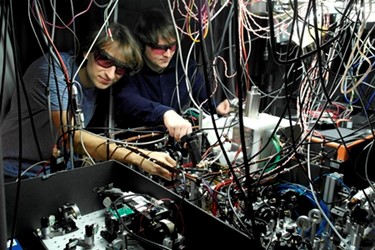Spin Waves Pair Up Like Photons

When two identical photons arrive at a half-reflecting piece of glass, in the quantum mechanical world they are always either both transmitted or reflected - they pair up. This effect, termed Hong-Ou-Mandel interference, should occur not only for photons, but for any bosons. Doctoral students at the Faculty of Physics, University of Warsaw (Quantum Memories Laboratory) now demonstrated this effect for bosons known as “spin waves”. Using a new method of manipulating the spin waves using a spatially-shaped laser beam they were able to realize an analogue of a half-reflecting glass (beam-splitter) for spin waves and demonstrate their Hong-Ou-Mandel interference.
A beamsplitter is a basic tool of a quantum physicist, especially those working in the field of quantum optics. This simple tool allowing to split a beam of light in to has many practical applications but also allows intricate demonstrations of peculiar quantum properties of Nature. The Hong-Ou-Mandel effect is an example of the latter.
To explain this intricate effect let us return to simple principles. Pauli exclusion principle forbids electrons to occupy the same states in an atom. The electrons are an example of a more general class of particles called fermions, which do not like to bunch together. On the other end of the spectrum, we have so-called bosons, theorized already in 1924 by Bose and Einstein, of which the most prominent example is photons - the elementary particles of light. When two identical photons meet on a beamsplitter, we could imagine that sometimes they will both reflect of it, sometimes they will both transmit through it, while in the rest of cases one photon will be transmitted and the other reflected. Yet, this is not what happens, as here we experience their bosonic bunching property and they always either are both transmitted or both reflected. This effect, discovered by Hong, Ou and Mandel in 1986, has been since then observed also for other bosons, such as plasmons and even large bosonic atoms.
On the Faculty of Physics of the University of Warsaw, in the Quantum Memories Lab led by Dr Wojciech Wasilewski, a new quantum memory for photons has been developed since 2016. During the three year period, the team of researchers demonstrated a record-breaking capacity of quantum states of light. Their effort required careful development of new control techniques for optical and magnetic fields in the system as well as gaining a new fundamental understanding of the spin-wave field theory. The work of PhD students in the lab thus ranged from experimental engineered to theoretical quantum physics.
In this memory, photons are stored in the form of collective excitations known as spin waves. A spin wave is a single excited atom delocalized in a large (0.3x0.3x5 mm) cloud of one billion atoms. Theory predicted, that those spin waves should have the same bosonic properties as photons, even though they are not truly elementary particles, rather being quasi-particles (i.e. they are made up of many other particles). A question remained how an analogue of a beamsplitter for spin waves could be realized, to demonstrate their bosonic bunching property. Doctoral students in the Quantum Memories Lab have finally been able to overcome this difficulty by manipulating spin waves with a shaped laser beam, for which they used an optimized laser projector.
With this carefully engineered laser beam, they have been able to shift energy levels of atoms in the ensemble so that a pair of spin waves could be forced to interfere, just as photons on a beamsplitter. Their method turns out to be even more versatile, as it can mimic elements such as lenses and diffraction gratings, now all realizable in the domain of spin waves. Using this method, they were finally able to observe the Hong-Ou-Mandel effect for spin waves with very high credibility. The high visibility of interference (measured by residual events in which bosons do not bunch) now allows using this method in quantum information processing.
One of the devices that can readily use the method developed in Warsaw is the quantum repeater. Quantum repeaters are devices essential in quantum communications, which allows complete security of communication, in this case, guaranteed by quantum entanglement. In a protocol proposed by Artur Ekert in 1992 two parties need to first share a pair of entangled particles over a long communication distance. They can then generate a secure key, as measurements of the spin of a particle at each site are random yet perfectly correlated. Photons are best for this task of entanglement distribution, as they can travel over a long distance in a fibre optic cable. However, since we are dealing we single quanta of light, a simple amplifier cannot be used. A quantum repeater is specifically designed to amplify this quantum signal. However, a fully functioning quantum repeater is almost as complex as a quantum computer. While big progress is seen in the field of quantum computers using superconducting qubits, current machines cannot be connected to an optical fibre network. Now, processing of spin waves facilitated by the beamsplitter operation developed at the University of Warsaw can fill in this gap to facilitate small-scale quantum information processing in a repeater node. While current devices can only hold 9 qubits and allow only for some operations on them, its uniqueness promises fascinating applications of the new method.
Physics and Astronomy first appeared at the University of Warsaw in 1816, under the then Faculty of Philosophy. In 1825 the Astronomical Observatory was established. Currently, the Faculty of Physics' Institutes include Experimental Physics, Theoretical Physics, Geophysics, Department of Mathematical Methods and an Astronomical Observatory. Research covers almost all areas of modern physics, on scales from the quantum to the cosmological. The Faculty's research and teaching staff includes ca. 200 university teachers, of which 77 are employees with the title of professor. The Faculty of Physics, University of Warsaw, is attended by ca. 1000 students and more than 170 doctoral students.
Source: Faculty of Physics of the University of Warsaw
